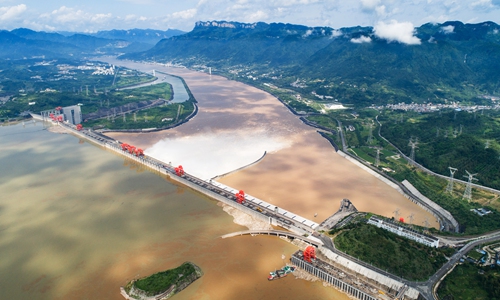
The Three Gorges Dam Photo: IC
A top Chinese hydraulic engineering expert said that the flooding in South China is and will remain under control as the Three Gorges Dam is playing its crucial role in retaining and intercepting flood water.
Stories fantasizing the dam being close to collapse pop up annually. But according to experts, even in face of severe floods and torrential rain this year, the dam will stay firm and strong as ever, if not stronger, rather than deformed or collapsed.
Wang Hao, an academician of the Chinese Academy of Engineering, and honorary director of water resources department with China Institute of Water Resources and Hydropower Research (IWHR), told the Global Times on Wednesday that China puts in place five lines of defense when it comes to flood prevention and control, i.e. interception in the main streams, control in tributaries, protection by embankments, flood detention basins in low-lying areas and management of urban development along rivers.
Sitting right in the main trunk of Yangtze River, the Three Gorges Dam acts as the first and central line of defense, drastically reducing flood discharge to the middle and lower reaches of the Yangtze River basin. The situation would be worse without the dam, according to Wang.
As of Tuesday, the dam had intercepted 10.7 billion cubic meters of floodwater with a maximum peak clipping ratio (the ratio by which flood is intercepted) of 46.7 percent in the latest round of floods, the Three Gorges Corp (CTG), operator of the mega project, told the Global Times.
The powerful floodwater will not bring down the Three Gorges Dam, which has 23 deep spillway holes and 22 surface spillway holes to efficiently release flood water and hence stay firm, according to Wang.
"China's largest recorded flood in the past 2,500 years was in 1870 with a peak flow of 105,000 cubic meters per second. The Three Gorges Dam is designed to withstand more, even a peak flow of 124,300 cubic meters per second," said Wang. Wang also introduced that there is still 21.1 billion m3 of flood control capacity on stand-by in the Three Gorges Reservoir, and risks in the Yangtze River basin are under control.
Experts said that the flooding in the South China this year is caused by the combined force of the Western Pacific subtropical high, westerly belt, plateau snow and global climate anomaly. Wang called for intensified rain and hydrological forecasts in the Yangtze River basin and more coordinated operation of reservoirs basin-wide.
According to the academician, 101 reservoirs along the Yangtze River, including the Three Gorges Reservoir, are engaged in a joint operation to curb the flooding. He said that there are 1,400 flood reporting stations in the Three Gorges area, covering 580,000 square kilometers of the upstream basin. Hydrological and meteorological data can be rapidly collected. The forecast can reach seven days in advance, and the accuracy of a 24-hour forecast reaches 98 percent.
There have been frequent rumors that the Three Gorges Dam is "deformed" or even close to collapse. In July 2019, a picture posted online showed a satellite image of a "crooked" Three Gorges Dam caught quite some eyeballs. It proved to be an unfounded rumor after the China Aerospace Science and Technology Corporation provided a high-resolution satellite picture of the dam that shows no deformity.
During its decades of history, from initial debate over whether the dam should be built, to its construction and to its operation and management till today, tremendous scientific research, practice and data monitoring have been conducted. These efforts prove that the behavior of the Three Gorges Dam is better than expectations and exceeds design standards, the China Gorges Dam Corp told the Global Times in a statement.
Western media have cast doubt on Wang's statement that the dam is becoming tougher as it fights with the waters and floods. He told the Global Times that his judgement is grounded.
"The Three Gorges Dam is a concrete gravity dam that offers the best level of stability and firmness. The concrete materials used by the dam are different from ordinary concrete, as it has higher durability and crack resistance… The special fly ash and other materials are still undergoing the hydration reaction (curing), continuously strengthening the core strength. It will reach its peak strength in 100 years, and then it will gradually age."
He said that the compressive strength (measured in megapascals or MPa) of the concrete of the Three Gorges Dam, which has been storing water for 17 years, has improved from the original design of 25 MPa to 43 MPa. Similarly, the compressive strength of the Hoover Dam in the US was elevated to 50 MPa from 25 MPa, after decades of operation.
The expert hopes his words will help ease the public concern over the Three Gorges Dam. Also on Wednesday, media reported that cruise routes on the Yangtze River, with passing the Three Gorges Dam as a highlight, will resume in mid-August after being suspended since January due to the pandemic.
Some observers believe that instead of focusing on the Three Gorges Dam, more attention should be paid to the risks presented by collapse of smaller dams along tributaries.
According to a hydraulic engineering specialist, 80 percent of China's 98,000 dams were built before 1958. Their embankments are of low standards with relatively weak flood control capabilities, requiring risk screening and engineering reinforcement. Among the 42 flood storage and detention areas in the middle and lower reaches of the Yangtze River, nine embankments have yet to be reinforced and parts of the levees have yet to be completed.
The situation will not ease significantly in the coming week as heavy rainfall are still to expect in the upper Yangtze River. If the monsoon strengthens and the rain belt moves north, heavy rainfall will shift toward the upper reaches of the Yellow River, easing the flood in the Yangtze River, Wang said.


